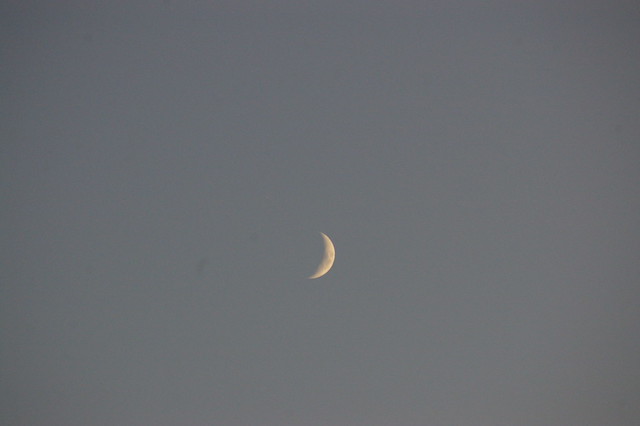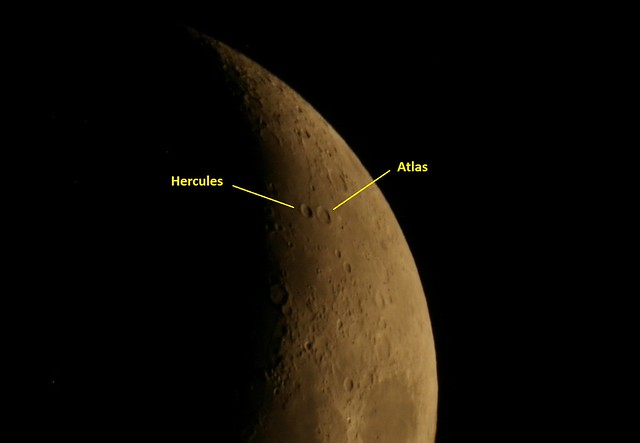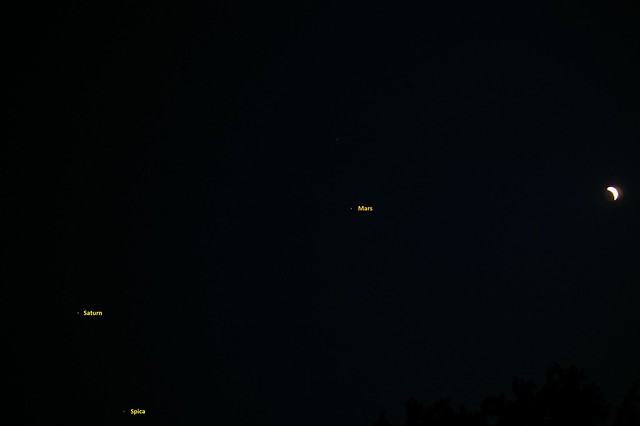
Despite a withering 103 degree temperature during the seven o’clock hour yesterday evening, I drug out my telescope and camera gear to the backyard in anticipation of an early evening planetary and lunar line-up. Terry grilled some chicken while I setup the scope, attached it to the portable battery and got the Autostar configured with the current date and time (almost straight up 8:00 pm). With forty minutes to go until sunset, I could clearly see the waxing crescent moon (see photo above), but the telephoto on my camera just couldn’t get me close enough to my lunar observing goal for the evening.
As I continue pursuing the Astro Quest observing award, created in 1995 by the ASKC Education Committee, I wanted to focus on the lunar section this month. The first item visible after a new moon happened to be the crater Hercules. Over the weekend, I researched all the lunar objects listed on the Astro Quest observing challenge, seeking images of the items first. I then determined I needed to find a lunar atlas. I have one for stars and deep sky objects (my handy Sky & Telescope Pocket Sky Atlas), but not a lunar one. Thanks to Google, I found the open source software called Virtual Moon Atlas, downloaded and installed it. I like it. The software makes it very easy to find features on the face of the moon and shows the current moon phase for my date/time and location.
I knew where to find the Hercules crater. Using my red dot finder scope, I honed the telescope in on the upper quadrant of the lit portion of the waxing crescent moon. Remembering to flip the image of the moon left to right in my head, I found the Hercules, and Atlas, craters easily. I spent several minutes using various eyepieces and barlows to zoom in for a closer look. I forgot to take a small portable table out with me to the backyard, so I didn’t have anything handy to take notes of my observations. I must get in the habit of doing this, if I plan to pursue other more stringent observing awards sanctioned by the Astronomical League.
I opted to mount my DSLR on the back of my telescope. I took a half dozen photos, none of which, upon downloading, were focused very well (grrrr). I selected the best of the bunch, cropped, labelled and uploaded it:

By this time, Terry had finished grilling supper, so I retired to the cool, air conditioned dining room to consume honey garlic grilled chicken and grilled Italian garlic bread with rice and Asian-style vegetables. He thoughtfully brewed some sun tea earlier in the day so I enjoyed two or three glasses of iced tea as well, knowing that I planned to return outside to the heat for more observing.
 After dinner, I returned to the backyard, where I could now see Saturn, Spica and Mars, as predicted by various astronomy alerts I’d received earlier in the day. I captured the southwestern horizon at 9:30 pm in Lansing, Kansas from Astronomy magazine‘s StarDome Plus Java applet to share here. I could see another star, besides Spica, above Mars, but I’m not exactly sure which one in the constellation Virgo it might have been.
After dinner, I returned to the backyard, where I could now see Saturn, Spica and Mars, as predicted by various astronomy alerts I’d received earlier in the day. I captured the southwestern horizon at 9:30 pm in Lansing, Kansas from Astronomy magazine‘s StarDome Plus Java applet to share here. I could see another star, besides Spica, above Mars, but I’m not exactly sure which one in the constellation Virgo it might have been.
Before shutting down the telescope and returning the camera to it’s tripod, and a normal lens with a wider field of view, I turned the ETX90 towards Saturn for a quick look. I did take one photo of the ringed gas giant, which turned out better than I thought it would:
I also tried again to see the polar ice cap on Mars, but the ETX90 just couldn’t provide enough light or magnification (through the eyepieces and barlows I own) to get much bigger than the head of a pin. I could clearly tell I was not looking at a star and that the color reflected back to my eye was a ruddy orangy pink, but I could not discern any other features of the Red Planet.
The moon shone just a tad too bright to easily capture the fainter Saturn and Mars in a single photograph. Of the dozen or so shots I took with various aperture settings, shutter and film speeds, I only found one that appeared adequate:
By ten o’clock, I had all the equipment back in the air conditioned house. I had voluntarily sweated outside during triple digit heat for nearly three hours to make a few astronomical observations. I spent a few blessedly cool moments sitting in front of the fan before downloading, reviewing, editing and uploading the photos I’d taken. Soon after, I fell into bed (near eleven o’clock and two hours past my bedtime), but tossed and turned all night long. When the alarm sounded at five o’clock, I slapped snooze three times until it forced me awake at half past the hour.
Another day, a Tuesday this time, and another triple digit heat index predicted for the Heart of America. Autumn can not arrive too soon.



